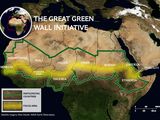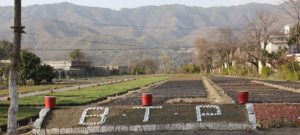Planting trees is the best way to tackle rising temperatures and climate change. Trees help to mitigate the impact of greenhouse gasses by taking carbon dioxide out of the atmosphere through the process of photosynthesis. Therefore, they help stop rising temperatures around the world. In addition, trees also keep soil moist and reduce the risk of flooding.
If this is the best climate change solution available today, what is being done around the world to plant more trees? Here are two of some of the ongoing massive projects.
The Great Green Wall

There is an 8,000 km wall of trees being built in Africa – making it the largest living structure on the planet once it’s finished. The wall aims to spread across the width of Africa and through more than 20 countries including Senegal, Nigeria and Ethiopia.
The Wall promises to be a compelling solution to the many urgent threats not only facing the African Continent, but the global community as a whole – notably climate change, drought, famine, conflict and migration.
A decade on from its launch, the wall is currently 15% complete, with 11.4 million trees planted in Senegal alone. In Burkina Faso, Mali and Niger, more than 2 million seeds have been planted from over 50 different species of trees.
Since the birth of the initiative in 2007, life has started coming back to the land, bringing improved food security, jobs and stability to people’s lives.
The Billion Tree Tsunami

Pakistan, through its massive reforestation project – named the Billion Tree Tsunami hit its target of planting a billion trees to combat the effects of climate change in August 2017.
Launched in 2014 the project was aimed at turning the tide on land degradation and loss in the mountainous, formerly forested KPK province in the Hindu Kush mountain range
Muhammad Tehmasip, Project Director of the project stated that, “The project is naturally restoring a previously deforested landscape, which will assist in meeting present and future needs and offers multiple benefits for climate adaptation and mitigation in a very climate-vulnerable province,”
Last year in 2018 the country set a new target, to plant 10 billion trees in the next five years to fight the effects of global warming by restoring the country’s depleted forests. As well as releasing more oxygen into the atmosphere, trees can protect Pakistan’s fast-eroding landscape by reducing the risk of floods from melting glaciers in its mountainous north.
Is That All It Takes?
The solution to the accelerating climate change crisis could be as simple as planting more trees. But, will planting 1 billion hectares of trees slow down climate change? The latest special report by the Intergovernmental Panel on Climate Change (IPCC) suggests that an increase of one billion hectares of forest will be necessary to limit global warming to 1.5 C by 2050.
The strategy is possible, but there are a number of caveats to go with it. This is because there is more to the story as there is need to balance between the sources (largely fossil fuels) and sinks (trees etc.).
University of Alberta Prof. Scott Chang, whose expertise is in forest soils and nutrient dynamics, points out that there are a number of potential obstacles to achieving this goal. He states that, “If we don’t curtail the usage of fossil fuels, if we don’t find alternate energy sources and if we continue to burn fossil fuel, we’re still going to be having the same problem so it’s still a temporary solution.”
Therefore, we need to decrease the sources while seeking to increase sinks to reduce the atmospheric CO2 concentration.



